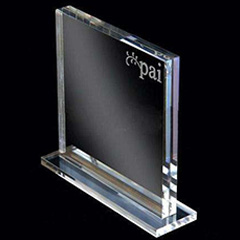The term 'acrylic' is used for products that contain a substance derived from acrylic acid or a related compound. Most often, it is used to describe a clear, glass-like plastic known as poly(methyl) methacrylate (PMMA). PMMA, also called acrylic glass, has properties that make it a better choice for many products that might otherwise be made of glass. There are two basic types: extruded and cast.
Types
Extruded acrylic is made through a process in which the liquid plastic is pushed through rollers, which press it into sheets as it cools. This is a comparatively inexpensive process, but the resulting sheets are softer than cast acrylic, can scratch easier, and may contain impurities. Extruded acrylic is still generally considered to be good quality, and is usually the more common type made available on the market.
Cell cast acrylic tends of be of higher quality than extruded, but it's also more expensive. In cell casting, single sheets are made by pressing the liquid plastic between pieces of a mold, often made of glass, which is then taken through a gradual heating process. The resulting sheet is stronger than extruded acrylic. This type is often used for aquariums, awards, and other products that require shaping or machining the final product.





